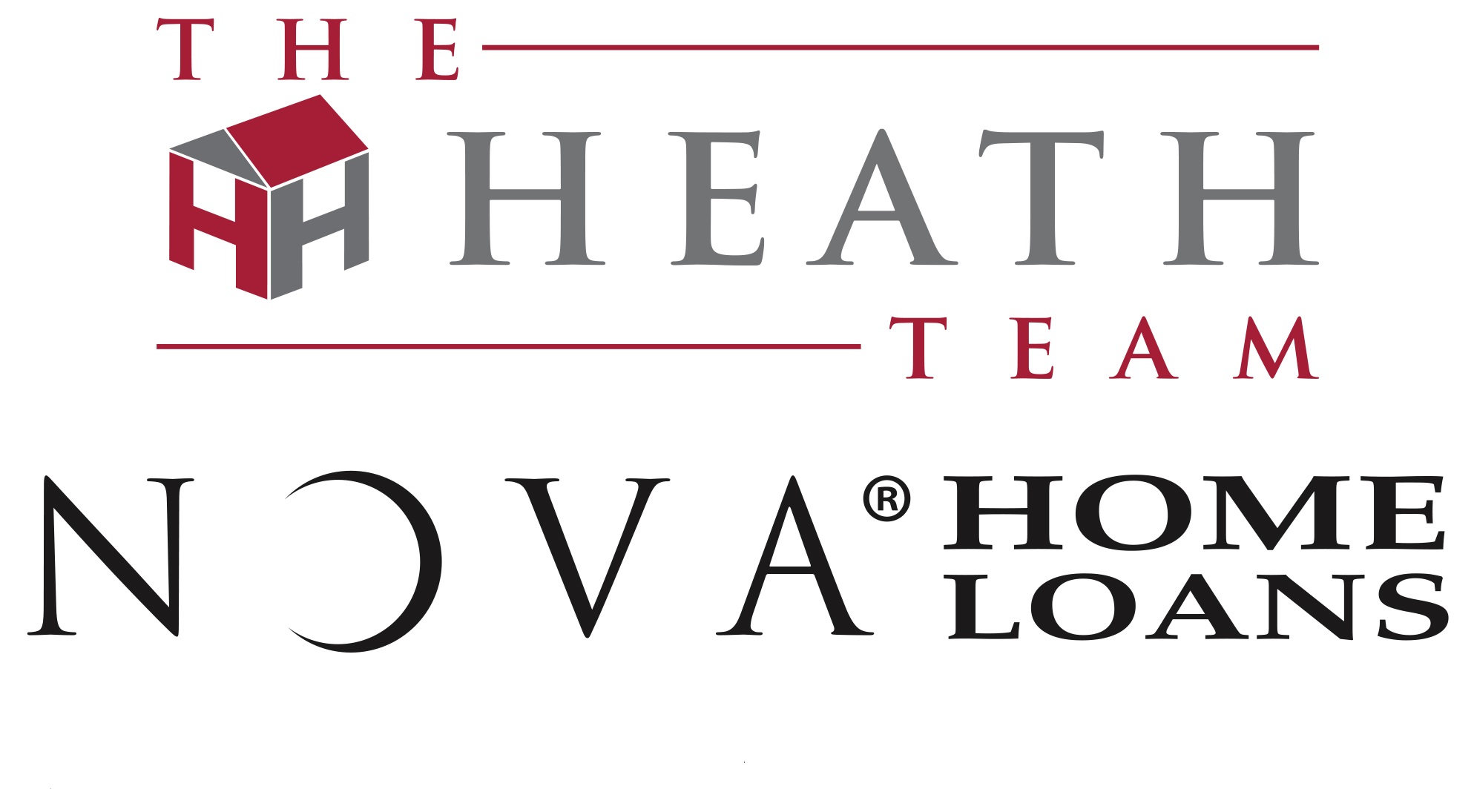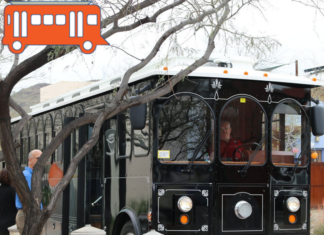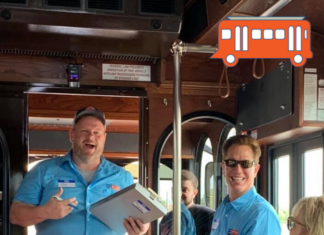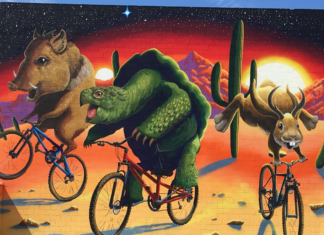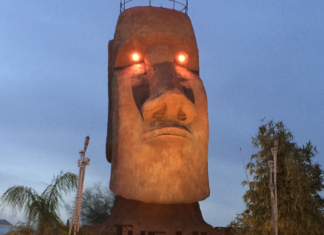Hello, my name is Tom Heath and I’m with the Heath Team at Nova Home Loans. And you are here for the first installment of our series on Tucson’s changing Urban landscape. The idea for this presentation actually started in 2018. When we put together a real estate agent tour on a bus, it looked like an old-time trolley, we put about 35 agents on that bus and we took them around to show them some of the things that were happening in the urban core.
We didn’t feel the time that there was a lot of understanding as to how much Tucson has grown and really the future that that it has that tour wasn’t meant to be a one-time event. It turned into a very popular event. We filled it up almost immediately and decided to do another one and the following month another one the following month. So this point we have done and a 15 or so tours. The real estate Community has been the the the primary audience for those tours because they are ambassadors of our real estate.
We want them to understand the impact of the urban core not just in for downtown and Fourth Avenue and University but also for all of Tucson in the region the Idea being on a bus these days is a little bit disconcerting for somewhere in May of 2020. So the the effects of the covid-19 pandemic or still with us and we are trying to do things more safely and responsibly so we put together this tour virtually with a lot of renderings from the developers and some actual pictures that we’ve taken and decided to put it out for you. This is a whirlwind tour. The full presentation is about an hour long. So we’re breaking it up into a Is a videos and I hope you enjoy it.
We’re going to cover it over this series of videos is why I’m here the things that I that in my past of led me to to be a presenter for this topic kind of the boundaries of the quote-unquote urban core. When did a lot of the stuff start to happen. What was the one of the foundation was that timeline and then what’s happened? What are the projects that have actually been completed. What’s under way? What’s planned and what’s possible?
The last two, plan and possible are the ones where we have the most questions right now because as I mentioned the covid-19 pandemic is still affecting our economy and will for some time. So the things that have happened and the things that are underway pretty solidly going to be affecting the urban core but what’s plan and what’s possible those may change. So if you hear of things that are different than what I’m presenting And keep in mind this is recorded in May of 2020 it very well could be different tomorrow a week from now a month from now. So feel free to check back with me or provide any updates that you may be aware of at the end of each of these series. I’m going to give you each one of these videos in the series. Let me give you a list of the websites where I recommend that you stay in touch to really see what’s happening in the urban core.
I’d like to start a little bit of the station with just something about myself. So you understand why I’m presenting this and get a sense of where I come from and the the perspective that I share. I’ve been in Tucson since 93 and I’d lived here for 20 plus years before I really started to explore Tucson to find out what amazing City that we have here in the Old Pueblo. I found out that there was a museum in the middle of downtown that fires off a cannon and Cannon every second Saturday and I was amazed that I hadn’t heard about this and then I started to investigate this the presidium museum and I found out that not only do they shoot off the cannon, but they do living history days. They reenact this 1775 arrival of the Spanish really creating the City of Tucson through the the their formation in their of the Presidio and it blew my mind that for being here as long as I have that I didn’t know anything about Tucson’s history and those trying to preserve it.
So I start exploring and just asking questions and just finding things that I didn’t know about. It turns out I really didn’t know much so to kind of summarize that the the the end result was that in 2017. I launched a radio show called Life along the streetcar. It’s on downtown radio and it’s still on the ship the air today. It’s 11. Every Sunday and we talk about the social cultural and economic impacts in the urban core. So I’ve had a chance to talk to a lot of the developers the decision-makers people that are part of our history and our culture really a lot of interesting people over the hundred and thirty some episodes that we’ve recorded they’re all available to you from Life along the streetcar dot org and invite you to check that especially if you’re trying to learn more about our region or if you’re trying to educate people about kind of the cool. Nature of the urban core well in 2019, I became a member of the downtown Tucson Partnerships board of directors and serve on the executive committee.
So again, I get to be around those that are shaping our Urban future here. The Tucson Association of Realtors is a place where I’ve had a couple of stints as a board director and again puts me in a position to really be around people that are impacting our community and a lot of really good and positive. sort of ways Then in 2019 that bottom slide there the Tucson Trolley Tours was the byproduct of these real estate agent tours. We found that a lot of non real estate professionals. Wanted to know more about Tucson, but they didn’t care about the economic development. They didn’t care about how many apartments were coming in or businesses were coming in. They want to know about the history and culture. So with a couple of Partners we put together this tour Tucson Trolley Tours and up and through March. We’ve been running every Saturday from nine to noon and we hope to get back to that in the fall once it’s safe and responsible to do so and that’s been a lot of fun to explore the history and culture and share that with people that might be new or we’re not even from Tucson.
The result of that was taking a Certification course in becoming a certified tourism Ambassador so that I can represent Tucson professionally and responsibly. Here’s a picture of the Canon that enamored me back in probably 2016 2017. And as you can see, I’m not the only one that was interested in how this this bad boy works there and that’s at the presidium Museum which is right at the corner near the YMCA and downtown near see. Hall and the historic Courthouse there and this is an idea of living history days that they do on second salaries. This was a specific event for the Luminarias event. They do in December where they fire off the muskets was very powerful very powerful presentation. You have a chance to check out the preceding Museum when they’re back open. I highly highly recommend it so over the course of these videos were going to talk about the urban core and There is no defined boundary of this. This is my perspective and what I’m talking about. So if you disagree with me, that’s fine. We certainly have that conversation.
But we’re going to go as far west as the Mercado and we’re going to go kind of as far east as the sunshine mile. But a lot of this is along the streetcar route. So it’s into downtown up to 4th Avenue into the university area. We do have a few projects in this. Speedway and Campbell and a few South here in Five Points. So this General radius is going to be the footprint of the series of videos a little bit of history is I believe it’s important to understand where we’ve been so that we have a sense of how that’s impacting us now and where we’re going but a lot of the current development was really kind of the impetus for this was a 1999 voter-approved initiative called Rio Nuevo.
The idea when voters approved this was it was going to be a mechanism to collect the taxes on from a portion of the state sales tax that’s collected on Broadway from pretty much the downtown all the way to park mall and those funds would be returned to Rio Nuevo for investing in revitalizing our downtown redeveloping our city core working on cultural projects and really trying to bring tourism back. To the history and culture of Tucson as well as helping Tucson Tucson has just restore their pride in our heritage. Well, there’s been a lot of negative press about the early days of ran away. But there’s been a few different iterations were on the third sort of board. If you will of Rio Nuevo and I don’t wanna get into the history of that and moved out if you have any questions give you my take on it, but you can also just check out with Rio Nuevo directly kind of their history and their present but for me in 2013 with The current Rio Nuevo board being appointed there was a dramatic shift in the effectiveness. And I think now starting in 2013 the voters wishes, you know, 14 years later. We’re starting to be recognized and granted because of the the new makeup of the board understanding the importance of investing Clarity and also being very transparent with how the funds are being used.
In 2006 we had the Regional Transportation authority and other voter-approved initiative that looked at the entire region and transportation related issues such as bus infrastructure and even light rail made an appearance in the RTA. So all the work you’re seeing on the freeway now and I-10 the Twin Peaks over past the stuff on I know road that was part of the Regional Transportation authority and if you’re driving through town, you’ll see these bus stops being created with the sign saying it. These are your RTA promise is being kept.
So this was 2006 and we’re seeing the benefits of that in part of this bill that was passed part of this Regional Transportation authority was actually funding for a light rail system, which was somewhat surprising because in 2003 just a few years before the idea of a light rail was put on the ballot and voters resoundingly said no, there’s a lot of opposition to it and then opposition dated away in 2006 partly because it was included with an overall Transportation plan. It wasn’t a standalone but also the RTA didn’t create enough money for light rail to actually take place in Tucson. What it did is it gave it a foundation saying that if you can find matching funds, you know have yourselves a light rail plan, but without that you don’t have anything.
So I think there was little thought in 2006 that there would be any reasonable opportunity for Tucson to get into the light rail business in 2008. Eight. We saw the Great Recession that changed the economic impact the economic Outlook of the globe and those impacts were felt everywhere including here in Tucson. Federal Government was looking for ways to stimulate the economy and one one such way is to for transportation infrastructure Investments to happen. So they created this grant the Tucson the transportation and infrastructure generating economic recovery the tiger Grant and if you remember the phrase of the day was shovel-ready projects the federal government wanted projects that could start immediately. They didn’t want things to languish for months and years and bureaucracy and planning stages.
Well Tucson comes along and says, hey we have a shovel ready project. We have a threesome mile streetcar route ready to go. We have an outline where it’s going to go. We have the general parameters, but we need we have half the money 65 million. We just need a little bit more we can make it go. Well, that was a very enticing offer for the federal government and they gave us the tiger Grant and with that. At the money they provided us with you know, a few other sources around town and the money that the voters had approved we had enough money for the streetcar the 2014 the streetcar became operational and it’s the Rio Nuevo Board of direct the streetcar and the sort of the willingness of tucsonans to adapt to change and and developers working now with a plan. It’s really Change the dynamic of Tucson. And now we see these cranes dotting our skylines and way that that I’ve never seen since I’m going to Tucson there’s six of them currently in the urban core three of them right around the convention center couple on Fourth Avenue in one University to and University.
So it’s quite exciting if you’re do Economic Development to see this. So let’s talk about changemakers. These are the foundations again my perspective of of things that have happened. In Tucson that had a lasting impact on development and will continue to drive Economic Development because of the success that they brought to the area and one of the first ones is this AC hotel by Marriott. The AC brand is mostly in Europe. There’s some in the United States as well. But when it was proposed for downtown Tucson, there were a lot of folks that were concerned that this very modern very Ultra Chic kind of European style hotel with a you know, a mid-level. Roof pool with a nice deck how that would actually do in Tucson economically since it’s right next to a lot of mom-and-pop own shops.
There’s a lot of historic buildings until it seemed a little bit out of place to a lot of people but what we have found in and since this open, you know is the first hotel being built in downtown since the 1970s and since it’s been opened, there’s been a tremendous amount of success. In fact, it’s been one of the top performing AC hotels across across the globe for Marriott. So it opened up a lot of eyes that okay this stretch from 1970 ish 2015. There’s a drought of hotels maybe that’s over because AC is performing well in downtown will see the effects of that as we get into later series on these videos. Another change maker for me was one East Broadway. This was a blueprint that we’re seeing a lot of developers replicate now as they do construction you have a Six or so story building with retail on the bottom office space and housing so mixed use and get not dependent upon one type of client, but you’re able to combine several different factors.
This is one East Broadway. And I think that was a change maker. My favorite changemaker Johnny Gibson’s downtown Market. This is our local grocery store. It is a great story of local Grocers coming together to create an opportunity where one was needed in the urban core, especially in the downtown area where we didn’t have the opportunity for fresh produce and fresh meat and those types of things the owners took on a spot that it was formerly Johnny Gibson a downtown iconic figure again going to the whole presentation. I just join a Gibson, but they took over a shop where he had used for his warehouse for his weight in gym equipment distribution. And they honored him by keeping his name attached to the downtown Market. This has been a transitional Market meaning it’s gone through several different iterations itself, depending on what the needs were of the time. So it’s only been open for you know, half a dozen years, but in that time frame, it’s it’s really shifted its identity to meet the needs of who is downtown because that demographic continues to change.
We’re likely to see a larger grocery store coming to the area, but without Johnny Gibson, but I don’t think we would have much as much of the residential activity because it really signified to people including myself who didn’t live downtown at the time, but do now that Tucson isn’t downtown Tucson isn’t just a place to party and have fun and a place to work. You can actually live and sustain yourself there and trying to give senseless was proof of that. Another change maker was the arena at the convention center. This is a Convention Center has been a big focus of the Rio Nuevo board and one of the first major Projects was this Arena? It did not have a great reputation. It was not a very big draw for a concert promoters outdated sound system outdated facility in general. So Rena way we’ll invested a lot of money into the TCC Arena and it paid off almost immediately. They were able and the contracts the Tucson roadrunners to bring a professional hockey team here to Tucson. It’s a high quality team one step below the NHL and their farm team of the Phoenix Coyotes. So it was really a good transition to bring them into into Tucson.
The success of the roadrunners brought another professional sports team the Tucson sugar skulls, which is an arena football league that brought that in here and the revamped Rena brought in much larger concerts that we have seen in some time and was a good Testament to the Rio Nuevo board that if they were to invest in things like this that they could get the results that they wanted and so for me, that’s why it’s a change maker. And the last one is Caterpillar. This was a interesting decision. It was very surprising National decision that caterpillar chose Tucson. There are global company. They were looking for a new headquarters for the North American operations. And the final two cities that were in the running were Tucson and Denver and there’s probably 95% of the population, you know, if they guess we’re taking odds with a 95% chance that they’re going to go to to. Denver and much to the surprise of maybe some of the caterpillar boys.
They chose Tucson and that was an eye-opening experience for a lot of folks. First of all the work from a state from a regional accounting a city and even a ran away vote District all of those had to work together to make this happen and that type of collaboration was a to see that be successful is very powerful for the When a place like Caterpillar goes to to to find a new location, they don’t just send out some of their employees to scout out some places. They actually hire experts called site selectors and they employ them to narrow down that search and then once that search is narrowed down the site selectors help these companies make their final decisions and when caterpillar chose Tucson it changed the perception of a lot of site selectors about the Vitality of our area and the opportunities for the employment Base education base and the just the beautiful weather and opportunities we have here.
They actually, the site selectors have a conference in Tucson soon after this and and I think that has led to some of the larger corporations choosing to put a footprint here in Tucson. So those are the foundational aspects of our video series some of the change makers and in the next segment of the series we’re going to start Get into projects and what’s actually happening in different areas around town. If you want more information, you can always go to these websites. They’re the ones that I stay involved with quite a bit the downtown Tucson Partnerships economic blog stuck together fantastic amount of data on their re in a way vote.org lists, all the projects that they are involved with and it’s also a very transparent side if you’re trying to track the money that Rihanna weibo is Raising. Through the tax revenue and what they’re doing with it the third website on there. It’s I think it’s a little bit under the radar. I think it’s one of the best development sites that you’re going to find in Tucson. It’s called Tebow Tucson Improvement beautification org a z so, it’s Tebow AZ dot Biz.
This is an individual that scours recording information and permitting information and puts together a complete picture of what’s Happening not just in the urban core but all around Around the metropolitan area. So I highly recommend if you’re interested in this type of development that you check out Tebow AZ dot Biz lifelong. The streetcar mentioned this at the top the idea there is history culture history cultural economic impacts in the urban core. It’s interviews that I’ve gotten to do over the last few years with the change makers in Tucson and very proud of the work that we do on that show. And if you’re looking to learn more about Tucson in the urban core, that’s a great place for you, too. Start and the last one. That’s just my personal page that we use for real estate agents. If you are looking to connect with us on presenting these types of this type of information to your client base or want to stay up to date or get on our next tour. You can head over to Tom’s tools for agents.com. So I appreciate your time today. Hope you tune back in for the rest of the series as we start to look at projects happening in Tucson’s Urban. Core. Thank you.
